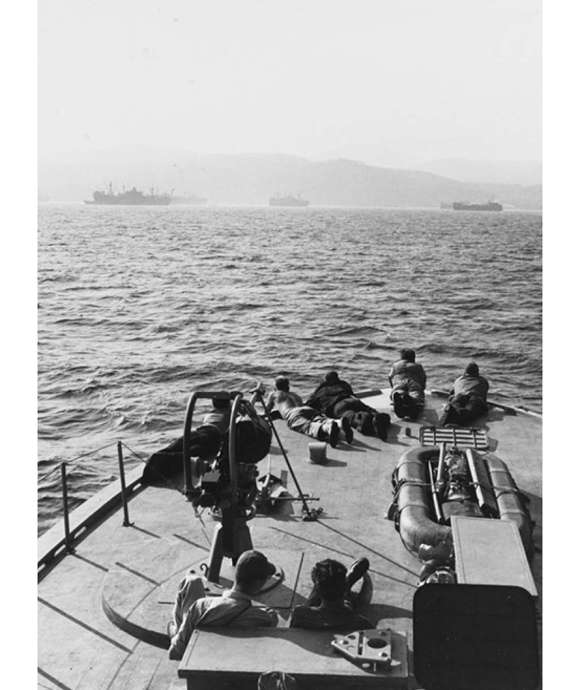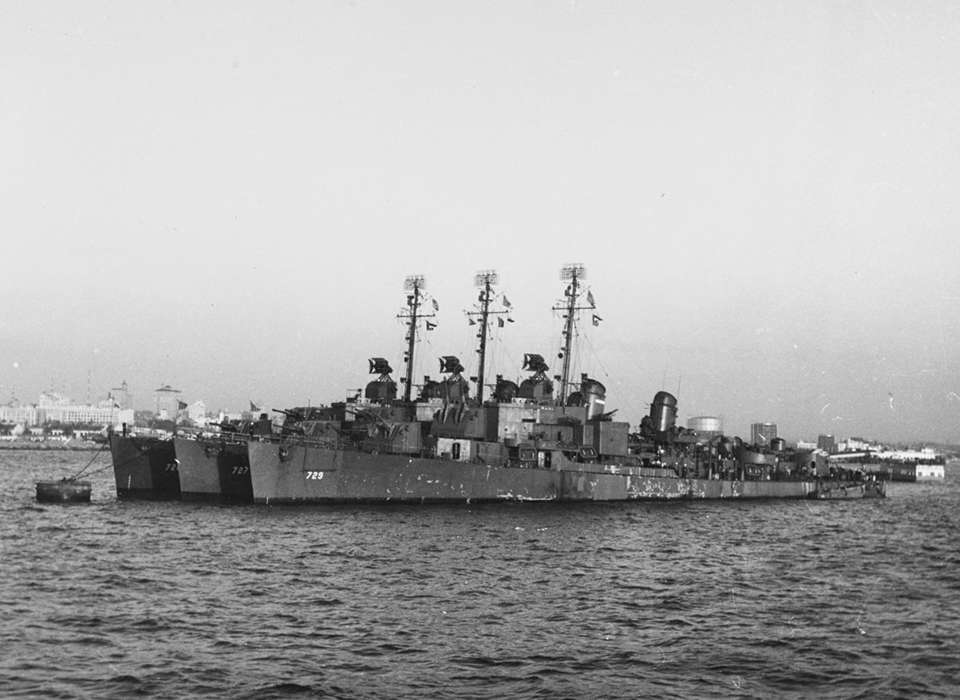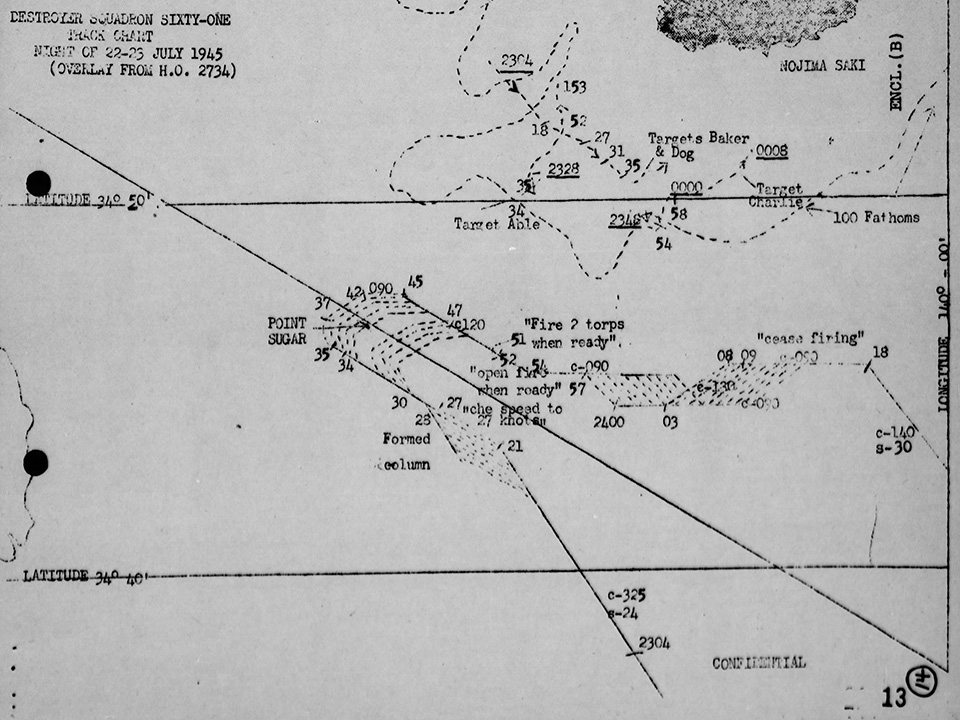By July 1945, the waters around the Japanese home islands were teeming with activity. Ships came and went as they pleased, operated with impunity in the coastal trade routes, and conducted military operations. There was a difference in the pace and makeup of these nautical activities from the previous years, however. Instead of the dramatically flared bows and peculiar pagoda masts of Japanese men-of-war, the ocean was well stocked with the powerful forms of US Navy warships. Legions of fast fleet carriers, resolute battleships, and nimble destroyers entered Japanese territorial waters with ill intent. It was time to land the final blows, and the US Navy was there to deliver them.
The US Navy had come a long way in the previous four years. Victory and defeats, archaic doctrines, tradition, and new technologies morphed into utter dominance. It was a force that was about to put another feather in its cap with the first US Navy surface incursion into the outer reaches of Tokyo Bay since the USS Astoria (CA-34) returned Japanese Ambassador Hiroshi Saito’s ashes in April 1939.
To be fair, US Navy submarines had been patrolling around the Japanese home islands since the beginning of the war, but their power could only stretch so far in the first few years. These submarines represented the strong grip, one that began by holding the Japanese by the ankle, but eventually had them firmly by the neck. The fleet represented the body blow. This was a long time coming, but it eventually arrived with unstoppable force that finished the opponent.
The first body blow was delivered by Task Force 58 in a series of air-raids in February and March 1945. Intended to support the invasions of Iwo Jima and later Okinawa, these raids were successful but demonstrated the danger of pressing a cornered enemy—the USS Franklin (CV-13) can testify to this. The next series of major raids began in July 1945, with the same ships ranging north but under a new commander, Admiral William Halsey Jr., and a new name—Task Force 38. For six weeks this great fleet roamed the Eastern approaches to Japan, launching strikes at will. Part of these dominating strikes were small operations called anti-shipping sweeps. They served as quick jabs between heavy blows, always serving to keep the enemy on their heels. The mission of these jabbing actions fell to the fleet destroyers of Task Force 38.
It is a bold move to detach a nine-ship squadron of destroyers from screening duty for a separate nighttime strike, but that is exactly the order given to the commander of Destroyer Squadron 61 on July 20, 1945. The orders were simple. The destroyers De Haven (DD-727), Mansfield (DD-728), Lyman K. Swenson (DD-729), Maddox (DD-731), Collett (DD-730), Taussig (DD-746), Blue (DD-744), Samuel N. Moore (DD-747), and Brush (DD-745) were to break away from escorting aircraft carriers and make a night time sweep of Sagami Bay. These waters were deep inside Japanese territory, and controlled the entrance to Tokyo Bay. Resistance could be anything from coastal artillery and aircraft, to escort vessels and mines. Split into two divisions, the destroyers were to race through the bay and sink any shipping encountered. If no ships presented themselves, they were free to bombard targets of opportunity as they charged in and out of the bay. This sweep was to be conducted on the night of July 22, 1945.
To further complicate the planning and execution, the destroyers were to sneak in on the heels of a typhoon that was supposed to rage through the area on the night of July 21.
The route was carefully calculated, navigation points established, and speeds dictated. Ships of each division were to maintain 500 yard spacing, with 3,000 yards between the two divisions. Traveling in column (one ship behind the other), the leader USS De Haven led the charge as the entire column worked up to 27 knots. At 2305, July 22, 1945, the radar on De Haven picked out a target 33,000 yards distant. Soon, four blips separated themselves from the coast, revealing a small convoy. Within 15 minutes the parade of American destroyers was moving in for a torpedo attack.
The movement of well-coordinated small combatants in this situation is similar to a school of fish. As commanders watch their radar screens they are looking for any movement that can tell what the enemy is doing. If one ship separates, is it the escort or is it just lost? Have they changed headings? Did they launch torpedoes? These are all questions that are open to interpretation and require action. Like the hand of a diver into a school of fish, their slight movements are calls for the entire destroyer division to change course. From first radar contact at 2305 until the order to launch torpedoes at 2351, Destroyer Squadron 61 made a number of turns to either close the range, reform their column, or avoid possible torpedoes. By 2351 this series of turns brought the division within 11,000 yards of the unsuspecting Japanese convoy.
This map from the De Havens after action report shows the movements of Destroyer Squadron 61 during the anti-shipping sweep into Sagami Bay. Courtesy of the National Archives.
On order from the commander, all nine destroyers began to release two torpedoes each at the four ships. As soon as all torpedoes were on the way the order to open fire was given. Each ship in Destroyer Squadron 61 was a Sumner-Class, armed with three turrets, each mounting two 5/38 cannon. Their ability to put out shells was epic. Between 2353 and 0009, just 16 minutes, the nine destroyers launched 18 torpedoes and fired 3,291 five-inch shells. The shocked and confused enemy could only respond with random, misdirected anti-aircraft fire as five-inch shells shredded their ships. To add insult to injury, two torpedoes found their mark. Mission accomplished, the column turned back to sea as two of the ships disappeared from radar. After action reports claimed two ships sunk, one probably sunk, and one heavily damaged. The sweep concluded, Destroyer Squadron 61 headed back to business as usual, escorting carriers of Task Force 38 for another two weeks of raids.
The fact that the US Navy was able to execute such a complicated operation in a successful manner shows how far light surface forces had come since the first engagements in the Solomon Islands in 1942. Radar and communications ruled the night as a relatively large surface force was able to navigate strange waters and launch a concentrated attack on a surprised convoy. Radar helped track the targets but it also provided navigational fixes that kept the entire formation in safe operating areas. Information and communications were equally important, with the Combat Information Center (CIC) on each ship painting a picture of the battle, providing a constant feed of information to the captain and the weapons systems. As each ship maneuvered with the group, all the weapons could remain trained on their targets, just waiting for permission to open fire. Even with new technologies, processes, and a very tired enemy, the first raid into the outer reaches of Tokyo bay took courage. The ability to accomplish such a dangerous mission on short notice, under the very nose of the enemy, on the tail of a typhoon, offers tribute to the fighting men of the US Navy.

Coastal Parade: The Final Naval Patrol in the Mediterranean Sea
How American PT boats became part of the last patrol conducted in the Mediterranean Sea.
Joshua Schick
Cite this article:
MLA Citation:
APA Citation:
Chicago Style Citation:










